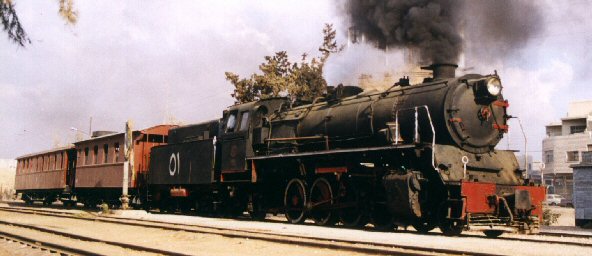The
Hejaz Railway
Construction of Hejaz Railway
"It
is a curious coincidence that during the reign of Sultan Abdul Hamid II,
the two ancient famous world trading roads, on the one hand from Cane
Emporium, the other from the Persian Gulf conducted through Arabia to
the Mediterranean Sea and Byzantium, torne off oblivion after almost
2000 years top be brought back to life; the Nabatean trade route of the
Sabians and by the construction of the Hejaz railway and the Palmyrene
trade route by the the Baghdad Railway. "
That is what Auler Pasha wrote in his travelogue
of 1907, but it's not just the ancient Nabatean trade route which
follows the construction of the Hejaz railway, it is especially the way
of the pilgrim road from Damascus to Medina and then to Mecca. There
were several serious reasons, because on the one hand the route was in
use since the early days of Islam, so supported by lots of supply
stations, water stations and fortresses (Khans) to protect the
pilgrims, and on the other hand the already existing facilities were
utilized by troops of the Ottoman army.
By order (Irade) of Sultan Abdul
Hamid II, announced on 1
May 1900, the construction of the railway from Damascus to Medina was
decided, in parallel to the imperial telegraph line. Previously, the
plan was to connect or transfer to the already in-use and, under French
leadership operated narrow-gauge railway from Muzeirib to Damascus. But
the high price of 7 million francs forced to change the plans for a new
line parallel to the existing route. Even the rare rail gauge of 1050 mm
was based on the narrow gauge of the French railway.
The first under the Ottoman Army Command
supervised construction proceeded very slowly, and despite of support of
Italian engineer La Belle, only 20 km installed route were finalized
after the first 6 months. Based on a reorganization and the relocation
of the site management to Damascus, the construction then proceeded
faster. That was also associated with the employment of the German
railway engineer Heinrich August Meissner in 1901, whome later was given
due to his excellent performance on the construction the honorary title
of Pasha by the Sultan.
Meissners reorganization
made it possible that the railway
was inaugurated in Medina on 1.
September 1908, the date of accession to the throne of Sultan Abdul
Hamid II.
A continuous construction of the railway from
Medina to Mecca and Jeddah, as originally planned, but due to the
historical events were never realized.
The
following opening dates have been announced:
|
From |
To |
km |
Opening |
closing |
|
Damaskus Cadem |
Dera’a |
123 |
1.9.1903 |
|
|
Dera’a |
Zarqa |
80 |
1.9.1902* |
|
|
Zarqa |
Quatrana |
124 |
1.9.1903 |
|
|
Qatrana |
Ma’an |
133 |
1.9.1904 |
|
|
Ma’an |
Mudawwara |
113 |
1.9.1905 |
|
|
Mudawwara |
Tabuk |
120 |
1.9.1906 |
1924 |
|
Tabuk |
Al Ula |
288 |
1.9.1907 |
1924 |
|
Al Ula |
Medina |
322 |
1.9.1908 |
1924 |
|
Damaskus Stadtmitte |
Damaskus Cadem |
5 |
1911 |
2005 |
|
|
|
|
|
|
|
Haifa |
Beisan |
59 |
14.1.1904 |
1948 |
|
Beisan |
Jizr al Mujami |
17 |
27.5.1904 |
1948 |
|
Jizr al Mujami |
Muzeirib |
73 |
15.10.1905 |
1948 |
|
Muzeirib |
Dera’a |
13 |
1.9.1901* |
|
* Originally began
with the early involvement of the Hejaz railway route to Damascus
Muzeirib
Since the material for rails and carriages as
well as the disposals like coal and lubricants had to be procured
exclusively from abroad, from the beginning a supply route was already
planned from Haifa to Muzeirib via Yarmuk valley. This line is due to
the difficult geographical situation a masterpiece of railway
construction, which yet dominates the services of construction of the
Hejaz railway.
The smallest
radius on the Hejaz railway was due to the narrow gauge system minimum
100 m.
The axle load was limited to
10 tons.
The rail yards had a weight of 21.5 kp, with the steel sleepers showing
a total track weight of 103 kp / m, all typical standards for a narrow
gauge railway.
There are more than 730 bridges, aqueducts and
water channels created as masonry.
In addition, there are 2
tunnels of 138 m (near Amman) and 162 m (near Tabuk) in length.
Nearly 100 posts and only a few railway stations are built at regular
intervals along the route. This applies especially to the southern part
since the Ottoman had to secure the route from local attacks and
sabotage.
The staff was divided into the construction
engineers, construction supervision, local contractors and laborers. The
latter group is mainly composed of soldiers and locally hired workers.
The proportion of military personnel in 1900 summed up to approximately
600 men, but rose rapidly to 5 500 men and reached the 1907 level of 7
500 men.
Progress of construction was divided into
sequences: The work ahead was performed by reconnaissance troops which
were followed by the surveyors. After determining the route, artificial
structures were immediately and simultaneously started prior to the
construction of embanquement. Only after setting the line, construction
of posts and railway
stations followed.
The supply to the railway construction was always
on the already fixed lines, the supply of water and food in front of
construction was supported by about 400 camels, owned and operated by
the local Bedouin tribes.
Particularly it must be mentioned that the supply
of water, but also partly the lack of fuel was one of the biggest
problems of the railway operation resorces and demanded a big part of
transport capacity.





